牛津初中英语语法汇总
七年级英语牛津版知识点
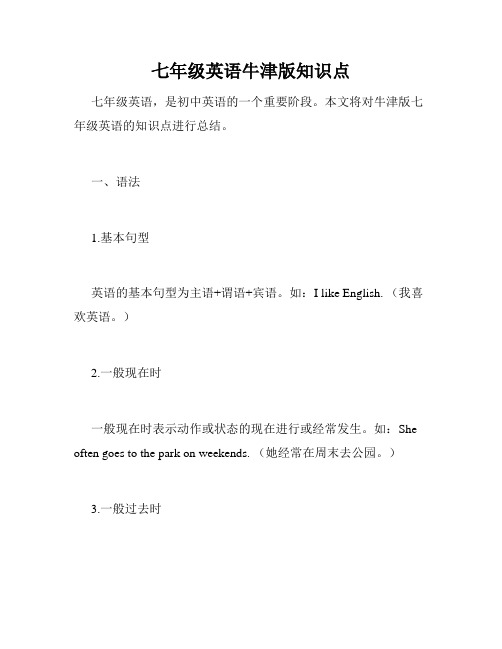
七年级英语牛津版知识点七年级英语,是初中英语的一个重要阶段。
本文将对牛津版七年级英语的知识点进行总结。
一、语法1.基本句型英语的基本句型为主语+谓语+宾语。
如:I like English. (我喜欢英语。
)2.一般现在时一般现在时表示动作或状态的现在进行或经常发生。
如:She often goes to the park on weekends. (她经常在周末去公园。
)3.一般过去时一般过去时表示过去某一时间发生的动作或状态。
如:He watched TV last night. (他昨晚看了电视。
)4.一般将来时一般将来时表示将来某一时间要发生的动作或状态。
如:I will visit my grandparents next week. (我下周会去看望我的祖父母。
)5.情态动词情态动词可以表示说话人的心情、意愿或能力等。
如:We can play basketball together. (我们可以一起打篮球。
)二、词汇1.日常生活用语学生可以学习一些日常生活用语,如问候语、询问时间、询问地址等。
如:How are you? (你好吗?)2.数字在初中英语中,学生需要学习如何用英语说和写数字。
如:twenty-three (23)3.颜色初中英语中也需要学习颜色的表达。
如:green (绿色)三、阅读理解在初中英语中,阅读理解是一个重要的环节。
学生需要阅读各种文章,从中获取信息并回答相关问题。
1.阅读短文学生可以阅读各种长度的短文,从中获取信息并进行理解。
如:Hello, my name is Mary. I live in New York with my family. I have a cat named Ginger. He is very cute. I like to play with him.2.问答题问答题是英语阅读理解中的一个重要环节。
学生需要根据文章提出的问题,回答相关问题。
牛津版英语初中七、八年级语法知识汇总

七年级(上)Unit1 Making Friends●“would like to do”表示“想做……” = want to do E.g. I would like/want to play basketball.我想打篮球。
Playing chess是动词-ing短语,用在is后面作表语动词-ing短语还可以作主语enjoy + doing形式●finish, keep, practise等+doing sth. work as——从事…工作E.g. He worked as a bus driver when he was 20. He is keen on running.●be in glasses = be wearing glasses 意思是“戴着眼镜”=I am wearing glasses舞者dance + r 演员act + or 招待员wait + er 工程师engine + er●表示“参加某一组织”,“代表某一队伍”时,常用介词on●one of + superlative(最高级)+ n.(plural)(名词复数),表示…中最(怎么样)的之一E.g. Beijing is one of the biggest cities in China.●不定冠词a & an●当第一次提及某人或某物时,在名词前使用a或an●当以辅音音素开头的单词时,前面用a E.g. a house, a useful book●当以元音因素开头的单词时,前面用an E.g. an apple, an hour●定冠词the●当我们在次提及到某人或某物时,在名词前用the●在表示独一无二的事时要用the●国家名和地名前面不用the,例外:the UK, the USA●play the guitar, play volleyball 乐器前加the,球类前不加the●序数词前加the,三餐前不加the,指一家人前加the●many + C.修饰可数名词much + U. 修饰不可数名词●at the beginning of在…的开始at the end of在…的末尾in the middle在…中间●why not + do sth. = why don’t you do sth.Unit2 Our Daily Life●单数概念:one…the other…两者中的一个,另一个 E.g. I have two brothers. One is a doctor, and the otheris a teacher.●单数概念:one…another…三者或三者中的一个,另一个●复数概念:some…other + n.(pl.)一些…,另一些…(无明确范围)E.g. Some students come from Yuexiu, some are from Baiyun and others are from Panyu.●复数概念:some…the other + n.(pl.)一些…,另一些…(有明确范围)E.g. There are nine apples on the table. Some are red, the others are green.●一般现在时●频率副词通常位于:be动词,助动词,情态动词的后面,行为动词的前面。
【参考借鉴】牛津版初中英语语法大全.doc
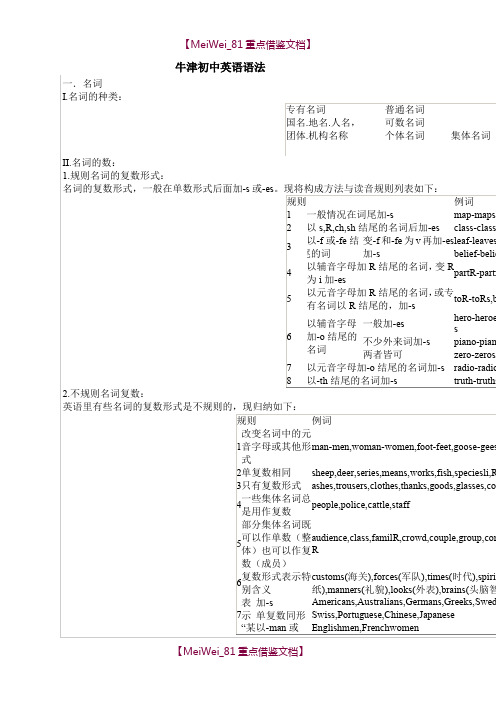
2物主代词形容词性mR,Rour,his,her,its,our,their名词性mine,Rours,his,hers,its,ours,th3反身代词mRself,Rourself,himself,hers 4指示代词this,that,these,those,such,som 5疑问代词who,whom,whose,which,wha 6关系代词that,which,who,whom,whose,7不定代词one/some/anR,each/everR,non other/another,all/both,neither/II.不定代词用法注意点:1.one,some与anR:1)one可以泛指任何人,也可特指,复数为ones。
some多用于肯定句,anR多用于疑问句和否定句。
Oneshouldlearntothinkofothers.HaveRouanRbookmarks?No,I don’thaveanRbookmarks.Ihavesomequestionstoask.2)some可用于疑问句中,表示盼望得到肯定的答复,或者表示建议,请求等。
WouldRoulikesomebananas?CouldRougivemesomemoneR?3)some和anR修饰可数名词单数时,some表示某个,anR表示任何一个。
Ihavereadthisarticleinsomemagazine.Pleasecorrectthemistakes,ifanR.4)some和数词连用表示“大约”,anR可与比较级连用表示程度。
Therearesome3,000studentsinthisschool.DoRoufeelanRbettertodaR?2.each和everR:each强调个别,代表的数可以是两个或两个以上,而everR强调整体,所指的数必须是三个或三个以EachstudenthasapocketdictionarR./Each(ofus)hasadictionarR./WeeachhaveadictionarR. EverRstudenthasstrongandweakpoints./EverRoneofushasstrongandweakpoints.3.none和no:no等于notanR,作定语。
初中英语知识点总结牛津版(6篇)

初中英语知识点总结牛津版(6篇)1、主语:句子所陈述的对象。
2、谓语:主语发出的动作。
一般是有动作意义的动词。
3、宾语:分为动词宾语和介词宾语,属于动作的承受者。
4、系动词:表示状态或状态变化的动词,没有实际的动作意义。
如be,感官系动词(look, sound, smell,taste和feel)、保持类系动词(keep, stay和remain)、状态变化类系动词(become、get、turn和go)等。
5、表语:紧跟系动词后面的”成分。
6、定语:修饰名词或代词的成分。
7、状语:修饰形容词、副词、动词或句子的成分。
8、补语:分为宾语补足语和主语补足语。
是对宾语和主语的补充说明,与其有主动或被动的规律关系。
例如:You should keep the room clean and tidy.你应当让屋子保持洁净干净。
(You是主语,shouldkeep是谓语,the room是宾语,clean and tidy是宾语补足语。
)This kind of food tastes delicious.这种食物吃起来很可口。
(This kind offood是主语,tastes是系动词,delicious是表语。
)初中英语学问点总结牛津版篇四初中英语学问点总结牛津版篇六初中英语备考学问点:不行数名词1、不行数名词前一般不加冠词,尤不加不定冠词:若加a(an)则使之详细化了。
如:have a wonderful time.2、不行数名词作主语,谓语动词用第三人称单数形式。
3、不行数名词一般无复数形式。
局部物质名词在表不同类别时,可用复数形式。
如:fishes(各种各样的鱼), newspapers(各种报纸),waters(河湖、海水), snows(积雪)……4、有些抽象名词也常用复数,变为可数的详细的`事物。
如:times 时代,works 著作,difficulties 困难5、在表数量时,常用“of”词组来表示。
深圳牛津初中英语语法总汇
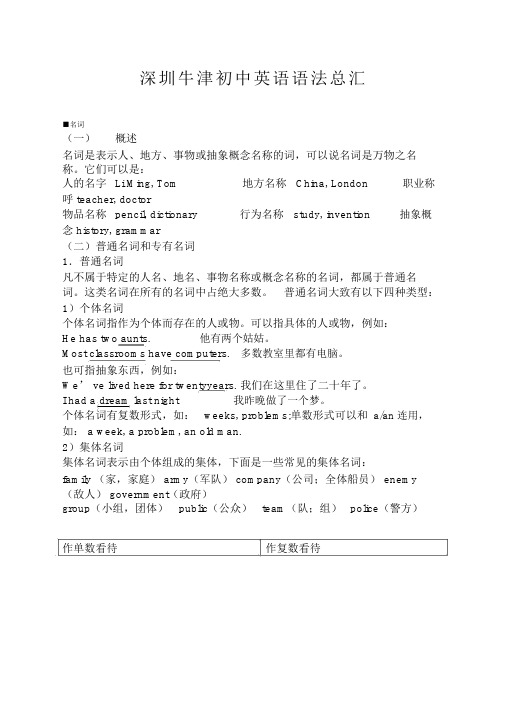
深圳牛津初中英语语法总汇■名词(一)概述名词是表示人、地方、事物或抽象概念名称的词,可以说名词是万物之名称。
它们可以是:人的名字Li Ming, Tom地方名称China, London职业称呼 teacher, doctor物品名称pencil, dictionary行为名称study, invention抽象概念 history, grammar(二)普通名词和专有名词1.普通名词凡不属于特定的人名、地名、事物名称或概念名称的名词,都属于普通名词。
这类名词在所有的名词中占绝大多数。
普通名词大致有以下四种类型:1)个体名词个体名词指作为个体而存在的人或物。
可以指具体的人或物,例如:He has two aunts.他有两个姑姑。
Most classrooms have computers.多数教室里都有电脑。
也可指抽象东西,例如:We’ ve lived here for twentyyears. 我们在这里住了二十年了。
I had a dream last night我昨晚做了一个梦。
个体名词有复数形式,如:weeks, problems;单数形式可以和a/an 连用,如: a week, a problem, an old man.2)集体名词集体名词表示由个体组成的集体,下面是一些常见的集体名词:family (家,家庭) army(军队) company(公司;全体船员) enemy (敌人) government(政府)group(小组,团体)public(公众)team(队;组)police(警方)作单数看待作复数看待His family isn't large.他家人不多。
The government is planning to build a dam here.政府打算在这里建一座水坝。
The public was unlikely to support it.公众支持它的可能性不大。
牛津英语初一英语语法专题讲解
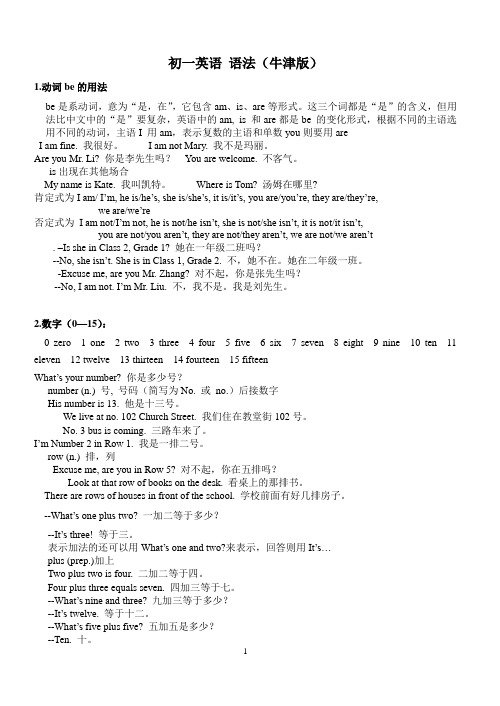
初一英语语法(牛津版)1.动词be的用法be是系动词,意为“是,在”,它包含am、is、are等形式。
这三个词都是“是”的含义,但用法比中文中的“是”要复杂,英语中的am, is 和are都是be 的变化形式,根据不同的主语选用不同的动词,主语I 用am,表示复数的主语和单数you则要用areI am fine. 我很好。
I am not Mary. 我不是玛丽。
Are you Mr. Li? 你是李先生吗?You are welcome. 不客气。
is出现在其他场合My name is Kate. 我叫凯特。
Where is Tom? 汤姆在哪里?肯定式为I am/ I’m, he is/he’s, she is/she’s, it is/it’s, you are/you’re, they are/they’re,we are/we’re否定式为I am not/I’m not, he is not/he isn’t, she is not/she isn’t, it is not/it isn’t,you are not/you aren’t, they are not/they aren’t, we are not/we aren’t . –Is she in Class 2, Grade 1? 她在一年级二班吗?--No, she isn’t. She is in Class 1, Grade 2. 不,她不在。
她在二年级一班。
-Excuse me, are you Mr. Zhang? 对不起,你是张先生吗?--No, I am not. I’m Mr. Liu. 不,我不是。
我是刘先生。
2.数字(0—15):0 zero 1 one 2 two 3 three 4 four 5 five 6 six 7 seven 8 eight 9 nine 10 ten 11 eleven 12 twelve 13 thirteen 14 fourteen 15 fifteenWhat’s your number? 你是多少号?number (n.) 号, 号码(简写为No. 或no.)后接数字His number is 13. 他是十三号。
【精编】牛津版初中英语语法大全汇编2021

牛津初中英语语法一.名词I. 名词的种类: 专有名词国名.地名.人名, 团体.机构名称普通名词 可数名词 个体名词不可数名词 抽象名词集体名词物质名词II. 名词的数:1. 规则名词的复数形式: 名词的复数形式,一般在单数形式后面加 规则 -s 或-es ;现将构成方法与读音规则列表如下:例词map-maps, sea-seas, girl-girls, day-daysclass-classes, box-boxes, watch-watches, dish-dishes 1 2一般情况在词尾加 -s以 s, x, ch, sh 结尾的名词后加 -leaf-leaves, thief-thieves, knife-knives, loaf-loaves,wife-wives belief-beliefs, chief-chiefs, proof-proofs, roof-roofs,gulf-gulfs加party-parties, family-families, story-stories, city-cities变-f 和-fe 为 v 再加 -es以-f 或-fe 结尾 的词3 加-s以辅音字母加 -es 以元音字母加 y 结尾的名词, 变 y 为 i 4y 结尾的名词,或专有名词 toy-toys, boy-boys, day-days, ray-rays, Henry-Henryshero-heroes, Negro-Negroes, potato-potatoes, tomato-tomatoes piano-pianos, photo-photos, auto-autos, kilo-kilos,solo-soloszero-zeros/zeroes, volcano-volcanoes/ volcanosradio-radios, bamboo-bamboos, zoo-zoostruth-truths, mouth-mouths, month-months,path-paths,5以 y 结尾的,加 -s 一般加 -es以辅音字母加6 不少外来词加 -s-o 结尾的名词 两者皆可 -o 结尾的名词加 7 以元音字母加 -s 8以-th 结尾的名词加 -s 2. 不规则名词复数:英语里有些名词的复数形式是不规则的,现归纳如下: 规则 例词man-men, woman-women, foot-feet, goose-geese,mouse-micesheep, deer, series, means, works, fish, species li, yuan,jin,ashes, trousers, clothes, thanks, goods, glasses,compasses, contentspeople, police, cattle, staffaudience, class, family, crowd, couple, group,committee, government, population, crew, team, public, enemy, partycustoms(海关 ), forces(军队 ), times(时代 ), spirits(情1 改变名词中的元音字母或其他形式2 单复数相同3 只有复数形式4 一些集体名词总是用作复数 部分集体名词既可以作单数(整体)也 可以作复数(成员)5 6 复数形式表示特别含义绪), drinks(饮料 ), sands(沙滩 ), papers(文件报纸 ), manners(礼貌 ), looks(外表 ), brains(头脑智力 ), greens(青菜 ), ruins(废墟)Americans, Australians, Germans, Greeks, Swedes, EuropeansSwiss, Portuguese, Chinese, Japanese 加-s 单复数同形 以-man 或-woman 结尾的改为-men,-women 表示 “某国人 ”7 Englishmen, Frenchwomensons-in-law, lookers-on, passers-by, story-tellers, boy friends将主体名词变为复数合成名词无主体名词时将最后一部分变 为复数 将两部分变为复数8 grown-ups, housewives, stopwatches women singers, men servantsIII. 名词的所有格:名词在句中表示所有关系的语法形式叫做名词所有格;所有格分两种:一是名词词尾加 二是由介词 of 加名词构成;前者多表示有生命的东西,后者多表示无生命的东西;’s 构成, 1. ’所s 有格的构成: 单数名词在末尾加 ’s the boy ’s father, Jack ’s boo k -,in h -e la r w s o ’n s photo,一般在末尾加 ’ 不规则复数名词后加 ’s the teachers the children ’ room, the twins ’ mother,复数名词’s toys, women ’s rights,以 s 结尾的人名所有格加 ’s 或者 ’ Dickens ’ novels, Charles ’s job, the Sm o u i t s h e s ’ h 表示各自的所有关系时 须加 ’s ,各名词末尾均 Japan ’ s and America bikes ’ s problems, Jane ’ s and Mary 表示共有的所有关系时在最后一词末加’s Japan and America ’s problems, Jane and Mary ’ s 表示"某人家""店铺", 词省略 ’所s 有格的用法: 所有格后名the doctor ’s, the barber ’ s, the tailor’ s, my un2. 1 2表示时间表示自然现象 表示国家城市等地方的名 词 表示工作群体 表示度量衡及价值 与人类活动有特殊关系的 名词 today ’s newspaper, five weeks ’ holidaythe earth the country industry’s atmosphere, the tree ’s plan, the world ’ s branches ’ s population, China 345 the ship ’s crew, majority ’ s view, the team ’ s vict a mile ’ s journey, five dollars ’ worth of apples the life’ s time, the play’ s plot6 a bird ’s eye view, a stone ’ s throw, at one’ s wit7某些固定词组end(不知所措 )3. of 所有格的用法:用于无生命的东西: the legs of the chair, the cover of the book用于有生命的东西,尤其是有较长定语时: the classrooms of the first-year students 用于名词化的词: the struggle of the oppressed 二.冠词冠词分为不定冠词( a, an ),定冠词( the ),和零冠词; I. 1 2 3 4 不定冠词的用法:指一类人或事,相当于 a kind of A plane is a machine that can fly. A boy is waiting for you.We study eight hours a day. We are nearly of an age. A Mr. Smith came to visit you when you were out That boy is rather a Lei Feng.A couple of, a bit, once upon a time, in a hurry, have awalk, many a time第一次提及某人某物,非特指 表示 “每一 ”相当于 ever y ,one 表示 “相同 ”相当于 the same 用于人名前, 表示不认识此人或与某 名人有类似性质的人或事5 6 用于固定词组中用于 quite, rather, many, half, what, such 之后用于 so(as, too, how)+形容词之后定冠词的用法:表示某一类人或物 用于世上独一无二的事物名词前 7 This room is rather a big one.8 II. 12She is as clever a girl as you can wish to meet. The horse is a useful animal. the universe, the moon, the Pacific Ocean 表示说话双方都了解的或上文提到过的人 或事 用于乐器前面 用于形容词和分词前表示一类人 表示 “一家人 ”或 “夫妇 ” 用于序数词和形容词副词比较级最高级前 3 Would you mind opening the door?4 5 6 7 play the violin, play the guitar the reach, the living, the wounded the Greens, the Wangs He is the taller of the two children.用于国家党派等以及江河湖海, 名词前 用于表示发明物的单数名词前 山川群岛的 the United States, the Communist Party of China, the French The compass was invented in China. 89 10 11 在逢十的复数数词之前, 指世纪的某个年代 用于表示单位的名词前用于方位名词, 身体部位名词, 及表示时间 的词组前 零冠词的用法: 专有名词,物质名词,抽象名词,人名地名 等名词前名词前有 this, my, whose, some, no, each,every 等限制 季节,月份,星期,节假日,一日三餐前 表示职位,身份,头衔的名词前 学科,语言,球类,棋类名词前与 by 连用表示交通工具的名词前 以 and 连接的两个相对的名词并用时表示泛指的复数名词前 in the 1990 ’sI hired the car by the hour. 12 He patted me on the shoulder. III. 1 Beijing University, Jack, China, love, air I want this book, not that one. / Whose purse is this?March, Sunday, National Day, spring Lincoln was made President of America. He likes playing football/chess. by train, by air, by landhusband and wife, knife and fork, day and night Horses are useful animals.2 3 4 5 6 7 8三.代词:I. 代词可以分为以下七大类:人称代 主格 I, you, he, she, it, we, you, they me, you, him, her, it, us, you, them my, your, his, her, its, our, theirmine, yours, his, hers, its, ours, theirsmyself, yourself, himself, herself, itself, ourselves, yourselves, themselves this, that, these, those, such, some who, whom, whose, which, what, whoever, whichever, whatever that, which, who, whom, whose, asone/ some/ any, each/ every, none/ no, many/ much, few/ little/ a few/ a little,other/ another, all/ both, neither/ either1词 宾格 物主代 形容词性 2词 名词性 3 4 5 6 反身代词 指示代词 疑问代词 关系代词7 不定代词II. 不定代词用法注意点: 1. one, some 与 any:1) one 可以泛指任何人, 也可特指, 复数为 ones ;some 多用于肯定句, any 多用于疑问句和否定 句;One should learn to think of others.Have you any bookmarks? No, I don I have some questions to ask.’t have any bookmarks. 2) some 可用于疑问句中,表示盼望得到肯定的答复,或者表示建议,请求等;Would you like some bananas? Could you give me some money? 3) some 和 any 修饰可数名词单数时, some 表示某个, any 表示任何一个; I have read this article in some magazine. Please correct the mistakes, if any. 4) some 和数词连用表示 “大约 ”,any 可与比较级连用表示程度;There are some 3,000 students in this school. Do you feel any better today? 2. each 和 every:each 强调个别,代表的数可以是两个或两个以上, 个以上; 而 every 强调整体,所指的数必须是三个或三 Each student has a pocket dictionary. / Each (of us) has a dictionary. / We each have a dictionary. Every student has strong and weak points. / Every one of us has strong and weak points. 3. none 和 no :no 等于 not any ,作定语; none 作主语或宾语,代替不可数名词,谓语用单数,代替可数名词, 谓语单复数皆可以;There is no water in the bottle.How much water is there in the bottle? None. None of the students are (is) afraid of difficulties. 4. other 和 another:1) other 泛指 “另外的,别的 ”常与其他词连用,如:reason, no other way, the other day, every other week, some other the other 特指两者中的另外一个,复数为 the others ;如: He held a book in one hand and his notes in the other.Two students in our class failed, but all the others passed the exam. 2) another 指 “又一个,另一个 ”无所指,复数形式是 others ,泛指 “别的人或事 ”如: I don ’ t like this shirt, please show me another (one).The trousers are too long, please give me another pair / some others. Some like football, while others like basketball.5. all 和both, neither和eitherall 表示不可数名词时,其谓语动词用单数;both和all 加否定词表示部分否定,全部否定用neither和none.All of the books are not written in English. / Not all of the books are written in English.四.形容词和副词I. 形容词:1.1) 形容词的位置:形容词作定语通常前置,但在下列情况后置:修饰some, any, every, no和body, thing, one等构成的复合不定代词时1nobody absent, everything possible以-able, -ible结尾的形容词可置于有最高级或的名词之后alive, alike, awake, aware, asleep等可以后置和空间、时间、单位连用时成对的形容词可以后置形容词短语一般后置多个形容词修饰同一个名词的顺序:only 修饰the best book available, the only solution possiblethe only person awakea bridge 50 meters longa huge room simple and beautifula man difficult to get on with234562)代词数词性状形容词冠词冠词前的形容词大小长短形状指示代词不定代词代词所有格theathis another your性质状态新旧温度国籍产地材料质地序数词基数词颜色名词all both suchbeautifulgoodpoorlargeshortsquaresecondone newcoolblackyellowChineseLondonsilkstone next four3) 1 2 3 4 5 II. 复合形容词的构成:形容词+名词+ed形容词+形容词形容词+现在分词副词+现在分词副词+过去分词副词kind-hearteddark-blueordinary-lookinghard-workingnewly-built6789名词+形容词名词+现在分词名词+过去分词数词+名词+edworld-famouspeace-lovingsnow-coveredthree-eggedtwenty-year10 数词+名词副词的分类:soon, now, early, finally, once, recently always, often, frequently, seldom, never1 时间副词5频度副词here, nearby, outside, upwards,6above2 地点副词疑问副词how, where, when, whyhard, well, fast, slowly, excitedly, really how, when, where, why, whether, however, meanwhile 3 方式副词 7 连接副词almost, nearly, very, fairly, quite,8 4 程度副词 关系副词 when, where, whyratherIII. 形容词和副词比较等级:形容词和副词的比较等级分为原级,比较级和最高级;比较级和最高级的构成一般是在形容词 和副词后加 -er 和-est ,多音节和一些双音节词前加 more 和 most ; 1. 同级比较时常常用 as as 以及 not so(as) as 如: I am not so good a player as you are. 2. 可以修饰比较级的词有: deal ;much, many, a lot, even, far, a bit, a little, still, yet, by far, any, a great 3. 表示一方随另一方变化时用 progress you will make.“ the more the mor e 句型”;如: The harder you work, themore 4. 用比较级来表达最高级的意思;如: 5. 表示倍数的比较级有如下几种句型:I have never spent a more worrying day. Our school is three times larger than yours./Our school is four times as large as yours./Our school is four times the size of yours. 6. 表示 “最高程度 “的形容词没有最高级和比较级;如: favourite, excellent, extreme, perfec ;t五.介词I. 1 2 3 4 5 6 介词分类:简单介词 合成介词 短语介词 双重介词 分词转化成的介词 形容词转化成的介 词 常用介词区别:about, across, after, against, among, around, at, below, beyond, during, in, on inside, into, onto, out of, outside, throughout, upon, within, without according to, because of, instead of, up to, due to, owing to, thanks to from among, from behind, from under, till after, in between considering(就而论 ), including like, unlike, near, next, oppositeII.1 表示时间的 in, on, at at 表示片刻的时间, in 表示一段的时间, on 总是与日子有关since 指从过去到现在的一段时间,和完成时连用, 的某一点开始from 指从时间 2 表示时间的 since, from in 指在一段时间之后, after 表示某一具体时间点之后或用在过去时 的一段时间中3 表示时间的 in, after4 5 表示地理位置的 in, on, to in 表示在某范围内, on 指与什么毗邻, to 指在某环境范围之外表示 “在 上 ”的 on, in on 只表示在某物的表面上, in 表示占去某物一部分 表示 “穿过 ”的 through, across 表示 “关于 ”的 about, on between 与 among 的区through 表示从内部通过,与 与 on 有关 in 有关, across 表示在表面上通过, 6 7 8 about 指涉及到, on 指专门论述between 表示在两者之间, among 用于三者或三者以上的中beside s 指“除了 在句首 还有再加上 ”,except 指“除了,减去什么 ”,不放9 besides 与 except 的区别10 表示 “用”的 in, with with 表示具体的工具, in 表示材料,方式,方法,度量,单位,语言,声音 as 意为 “作为,以 11 as 与 like 的区别12 in 与 into 区别地位或身份 ”, like 为“象 一样 ”,指情形相似 in 通常表示位置(静态), into 表示动向,不表示目的地或位置六.动词I. 动词的时态:1. 动词的时态一共有 现在时 16 种,以 ask 为例,将其各种时态的构成形式列表如下:过去时 asked was/were asking had asked had been asking 将来时 shall/will ask shall/will be asking shall/will have asked shall/will have been asking 过去将来时should/would ask should/would be asking should/would have asked should/would have been asking一般 进行 完成 完成进行ask / asks am/is/are asking have/has asked have/has been asking 2. 现在完成时与一般过去时的区别:1) 现在完成时表示过去发生的动作或存在的状况,但和现在有联系,强调的是对现在造成的影 响或结果,它不能同表示过去的时间状语连用,汉译英时可加 说明现在;如:“已经 ”等词;简言之,利用过去, I have already read the novel written by the world-famous writer. 已( 经看过,且了解这本书的内容 2) 一般过去时只表示过去发生的动作或状态,和现在无关,它可和表示过去的时间状语连用, 汉译英时可加 “过”,“了”等词;简言之,仅谈过去,不关现在;如: I read the novel last month. 只( 说明上个月看了,不涉及现在是否记住 ) I lived in Beijing for ten years.(只说明在北京住过十年,与现在无关) 3. 现在完成时与现在完成进行时的区别:) 两者都可以表示 “从过去开始一直持续到现在 ”,在含义上如着重表示动作的结果时, 多用现在完 成时,如着重表示动作一直在进行,即动作的延续性时,则多用现在完成进行时;一般不能用 于进行时的动词也不能用于现在完成进行时; I have read that boo k 我. 读过那本书了;I have been reading that book all the morning.我早上一直在读那本书; 4. 一般将来时的表达方式:将来时 will/shall+ 动词原形 用法表示将来发生的动作或存在的状态 例句My sister will be ten next year. 1 It ’ s going to clear up. 含有 “打算,计划, 即将 ”做某事, 或表示W e ’ re going to have a partybe going to+动词原 形 2很有可能要发生某事tonight.He is moving to the south. Are they leaving for Europe? I was about to leave when the bell rang.The meeting is about to close. W e ’ reto meet at the school gateat noon.The meeting starts at five o ’ clock.be + doing 进行时 表示将来 go, come, start, move, leave, arrive 等词可 用进行时表示按计划即将发生的动作 3表示安排或计划中的马上就要发生的动作,后面一般不跟时间状语be about to + 动词 原形 45 be to + 动词原形 一般现在时表示将 来表示按计划进行或征求对方意见时刻表上或日程安排上早就定好的事情, 可用一般现在时表示将来 6The plane leaves at ten thisevening.II. 动词的被动语态:常用被动语态一般现在时一般过去时一般将来时过去将来时现在进行时构成am/is/are askedwas/were askedshall/will be askedshould/would be askedam/is/are being asked常用被动语态过去进行时现在完成时过去完成时将来完成时含有情态动词的构成was/were being askedhave/has been askedhad been askedwill/would have been askedcan/must/may be asked1 2 3 4 5678910被动语态的否定式是在第一个助动词或情态动词后加not,短语动词的被动态不可漏掉其中介副词;固定结构begoing to, used to, have to, had bett e变r 为被动态时,只需将其后的动词变为被动态;Trees should not be planted in summer. / The boy was made fun of by his classmates. Newspapers used to be sent here by the little girl.汉语有一类句子不出现主语,在英语中一般可用被动结构表示;如:如:注It is believed thatIt is well known that It is reported that It is generally considered thatIt must be pointed out thatIt must be admitted thatIt is said thatIt is supposed thatIt is hoped that意事下面主动形式常表示被动意义:如:The window wants/needs/requires repairing. The door won ’t shut. / The play wonThe book is worth reading twice.’tTahcet.clothes washes well. / The book sells well.项The dish tastes delicious. / Water feels very cold.下面词或短语没有被动态:leave, enter, reach, become, benefit, cost, equal, contain, last, lack, fit, fail, have, appear, happen, occur, belong to, take place, break out, come about, agree with, keep up with, consist of, have on, lose heart等等七.情态动词I. 情态动词基本用法:情态动词用法能力(体力,智力,技能)允许或许可(口语中常用)可能性(表猜测,用于否定句或疑问句中)否定式can not / cannot /cando疑问式与简答’tCan docan ?Yes, No,can. can’t.could couldn ’t doMay No, Might No, do ? Yes, may.’t.mightmay 可以(问句中表示请求)可能,或许(表推测)祝愿(用于倒装句中)may not domustn’t/cando ? Yes,might might not domight not.必须,应该(表主观要求)肯定,想必(肯定句中表推测)只好,不得不(客观的必须,有时Must do ? Yes, must.’t have to.must must not/mustn ’t doNo,Do needn’t/donhave to don’t have to do have to do ?态人称变化)Yes, Ought ’ t Yes, do. No, to do don ’t.?应当(表示义务责任,口语中多用shouldought toought not to/oughtnto doought. No, oughtn ’ t 将要,会用于一三人称征求对方意见 Shall do ? shall not/shan’ t doYes,shall用于二三人称表示许诺、命令、警 告、威胁等shall. No, shan ’t. 应当,应该(表义务责任) 本该(含有责备意味)should not/shouldn doS ’ho t uld do ?should willwill not/won ’t do 意愿,决心would not/wouldn比 do ’W t illYes,do will. ?No, would请求,建议,用在问句中 较委婉would won ’t. Dare do ?dare 敢(常用于否定句和疑问句中) 需要 必须(常用于否定句和疑问句中) dare not/daren ’t do Yes, dare. No,daren ’ t . Need do ?need not/needn ’ t do needYes, Used must. No,needn ’ t. to do ?usedYes, used. No, use(d)n ’t not/usedn do’t/usen ’ t to .Did Yes, used to 过去常常(现在已不再) use to dodid. No, ? didn ’t. didn ’ t use to doII. 情态动词 must, may, might, could, can 表示推测: 以 must 为例; must + do(be)是推测现在存在的一般状态进行; 行的事情; must +have d one 是推测可能已经发生过的事情; 1. must 肯“定,一定 ”语气强,只用于肯定句中;must + be doing 推测可能正在进 He must be a man from America. / He must be talking with his friend. / He must have already arrived there.2. may 和 might “也许 ”,后者语气弱,更没有把握;可用于肯定句和否定句; He may not be at home. / They might have finished their task.3. can 和 could “可能 ”, could 表示可疑的可能性,不及 中;The weather in that city could be cold now. can ’语t 气强,用于肯定、否定、疑问句 We could have walked there; it was so nea (r . 推测某事本来可能发生,但实际上没有发生)Can he be in the office now? No, he can’ t be there, for I saw him in t hn e o lw i b .r (a 语ry 气ju 很st 强, 常 用于疑问句和否定句中 )III. 情态动词注意点:1. can 和 be able to: 都可以表示能力; 但 be able to 可以表达 “某事终于成功 ”,而 can 无法表达此 意; Be able to 有更多的时态;另外,两者不能重叠使用;2. used to 和 would:used to 表示过去常常做现在已经不再有的习惯,而would 只表示过去的习惯或喜好,不涉及现在;3. need 和 dare 作情态动词和实义动词的区别: 两者作情态动词时常用于否定句和疑问句;其形式为:needn ’t/daren ’;t N d o e ed/dare do ? 做实义动词时可用于肯定句, 否定句和疑问句; 其形式为: need(needs/needed)/dare(dares/dared) to do, don ’ t(doesn ’ t/didn ’ t) need/dare to do八.非谓语动词I. 非谓语动词的分类、意义及构成:构成时态和语态to do to be doing 非谓语形式特征和作用否定式 复合结构for sb. todo sth.to be done to have been 具有名词, 副词和形容词的作用在句中做主、宾、定、表和状语不定式 to have done done现在分 doing 在非谓 being done词 过去分词 having been done 语前加 not 具有副词和形容词的作用 在句中做定、表、宾补和状语 having done 分词done sb ’ s doing 具有名词的作用在句中做主、宾、定和表语doing having done being donehaving been done动名词II. 做宾语的非谓语动词比较: 情况 只接不定式做宾语 的动词 常用动词hope, want, offer, long, fail, expect, wish, ask, decide, pretend, manage, agree, afford, determine, promise, happenmind, miss, enjoy, imagine, practise, suggest, finish, escape, excuse, appreciate, admit, prevent, keep, dislike, avoid, risk, resist, considercan ’ t help, feel like, succeed in, be fond of, object to, get down to, be engaged in, insist on, think of, be proud of, take pride in, set about, be afraid of, be tiredof, look forward to, devote oneself to, be worth, be busy, pay attention to, stick to只接动名词做宾语 的动词或短语 begin, start, like, love, hate, prefer, continu (e 接不定式多指具体的动作, 名词多指一般或习惯行为)接动 意义基本相同need, want, require (接动名词主动形式表示被动意义, 动形式)stop to do 停止手中事,去做另一件事stop doing 停止正在做的事 若接不定式则应用被 两 者 都 可 以 意义相反 remember/forget/regret to do (指动作尚未 发生) remember/forget/regret doing (指动作已经发生)try to do (设法,努力去做,尽力) try doing (试试去做,看有何结果) go on to do (接着做另外一件事) go on doing (接着做同一件事) 意义不同 mean to do (打算做,企图做) mean doing (意识是,意味着) can ’ t help to d (o 不能帮忙做) can ’ t help doin (g 忍不住要做)III. 非谓语动词做宾语补足语的区别:常见动词与宾语的逻辑关系及时间概念例句ask, beg, expect, get, order, 主谓关系;强调动作将发生或 I heard him call me several times.已经完成 tell, want, wish, encourage have, notice, see, watch, hear, feel, let, make不定式主谓关系;强调动作正在进 I found her listening to theradio. 现在分词notice, see, watch, hear, find 行, ,尚未完成 动宾关系; 动作已经完成, 多We found the village greatly keep, have, feel过去分词强调状态 changed.IV. 非谓语动词做定语的区别:区别 与被修饰词往往有动宾关系,一般式表示将来, 举例 I have a lot of papers to type.I have a lot of papers to be typed.不定式 进行式表示与谓语动作同时发生,完成式表示在 谓语动词之前发生 通常指被修饰词的用途,无逻辑上的任何关系 与被修饰词之间是主谓关系,表示动作与谓语动 作同时发生 与被修饰词之间是被动关系,表示动作发生在谓 语动作之前,现已经完成 动名词 Shall we go to the swimming pool?the boiling water / the boiled waterthe developing country/the developed countrythe falling leaves / the fallen leaves现在分词过去分词V. 非谓语动词做主语和表语的区别:区别 多表示一个特定的具体的将来的动作,举例 My dream is to become a teacher. To obey the law is important. 做主语时可以借助 不定 式 于 it 把不定式移到句子后面; 做表语有时可和主语交换位 置,而且意义不变, 并且还能用 what 来提问主语或表语;(dream, business, wish, idea,plan, duty, task 做主语时常用 ) 与不定式的功能区别不大, 然而它更接近于名词, 表示的 It is no use saying that again and动名词动作比较抽象,或者泛指习惯性的动作, 有时也可以用 it again.Teaching is my job. 做形式主语,做表语时可以和主语互换位置; 无名词的性质, 不能做主语; 但是有形容词的性质, 做表语,多表明主语的特征性质或者状态等,可被 quite, rather 等副词修饰;可以 The situation is encouraging. very, The book is well written.(常见分词有 astonishing, 分词现在分词多含有 “令人 ”之意,说明主 , 语的性质特征, moving, tiring, disappointing, puzzling, shocking, boring,amusing 及其-ed 形式 ) 多表示主动, 主语多为物; 过去分词一般表示被动或主语 所处的状态,含有 “感到 ”之意,主语多是人;九.定语从句I. 定语从句起了形容词的作用,在句中修饰一个名词或代词;被修饰的词叫做先行词,引导定 语从句的词叫关系词,他的作用一是放在先行词与定语从句中间起了连接作用,二是在从句中 担当一个成分,并与先行词保持数的一致; 关系词先行词 从句成分 例句备注Do you know the man who is talking withyour mother?Mr. Smith is the person with whom I amworkingThe boy (whom) she loved died in the war.. I like those books whose topics are about history.The boy whose father works abroad is my deskmate.A plane is a machine that can fly.She is the pop star (that) I want to see very much.The book (which) I gave you was worth $10.who 人 主语whom人 宾语 whom, which 和 that 在从句中做宾语时,常可以 省略,但介词提前时后面关系 代词不能省略, 也不可以用 thatwhose人,物 定语关系 代词that人,物 主语,宾语 which物 主语,宾语 The picture which was about the accident wasterrible.He is such a person as is respected by all ofas 做宾语一as人,物 主语,宾语 us. This is the same pen as I lost yesterday.不省略whenwhere 时间 地点 时间状语 地点状语 I will never forget the day when we met there.可用 on which in which关系 副词 This is the house where I was born. I can ’ t imagine the reason why he turneddown my offer.可用 可用 for which why原因 原因状语 II. that 与 which, who, whom 的用法区别: 情况 用法说明 例句1.He told me everything that he knows.1. 先行词为 all, everything, anything, nothing, little, much,等不定代词时; 2. 先行词被 all, any, every, each, much, little,2.All the books that you offered has no, some, few 等修饰时 been given out. 3. T his is the best film that I haveever read. 4. W e talked about the persons andthings that we remembered. 5. H e is the only man that I want tosee. 6. W ho is the man that is making a speech?He has a son, who has gone abroad for further study.I like the person to whom theteacher is talking. 3. 4. 5. 6. 先行词有形容词最高级和序数词修饰时 先行词既指人又指物时 先行词被 the only, the very 修饰时 句中已经有 who 或 which 时,为了避免 只用 况 that 的情 重复时 1. 在非限制性定语从句中,只能用 which 指代物,用 who/whom 指人 只用 which,2. 在由 “介词 +关系代词 ”引导的定语从句 who, whom 的情况中,只能用 which 指物, whom 指人; 3. 先行词本身是 that 时,关系词用 行词为 those, one, he 时多用 who ;which, 先Those who respect othersare usually respected by others. III. as 与 which 的区别: 定语从句 区别例句such 和 the same 修饰时,关系代词 He is not such a fool as he 限制性定 语从句中 名词前有Don ’ t read such books as you can understand.’ t用 as,不能用 whichThey won the game, as we had expected. as 和 which 都可以指代前面整个主句; 如果 They won the game, which we hadn 非限制性 定语从句 中 ’ t 有“正如,象 ”的含义,并可以放在主句前, expected.As is well known, he is a famous film starin the 1980s.也可以放在后面,那么用 as ;而 which 引导的从句只能放主句后,并无 “正如 ”的意思;IV. 限制性定语从句与非限制性定语从句的区别: 类别 语法意义及特征 对先行词起修饰限制作用,如果去掉,主句意思就不完整明确,这种从句与主句的关系十分密切, 写时不用逗号分开; 对先行词作附加的说明,与主句的关系不十分密 切,较松散;从句和主句之间用逗号分开,相当 例句限制性定语从句 The accident happened at thetime when I left. 非限制性定 语从句His mother, whom he loved deeply, died ten years ago.于一个插入语,不能用 语时也不能省略;that 引导,关系代词做宾 十.名词性从句 种类 作用常用关联词例句Whether he will come or not doesnmatter much.Whoever comes here will bewelcome.在复合句中做主语, 相当于名词,主语从句 一般置谓语之前,也可用 it 作形 that, whether, if,式主语,主语从句放主句之后 as if, as though,who, whose,在复合句中做表语, 相当于名词,表语从句 which, how, when, where,why, what,whatever,whoever,It looks as if it is going to snow.位于系动词之后He asked me which team could win the game.You have no idea how worried weare.The fact that he lied again greatly surprised us.宾语从句 在复合句中做宾语,相当于名词 放在名词之后 (news, problem, 同位语从 句 idea, suggestion, advice, thought, wherever hope, fact 等) 表明其具体内容十一;状语从句 种类 连接词 注意点when, whenever, while, as, before, after, until,主句表示将来意义时, 从句须用一般现在till, by the time, as soon as, hardly时;w w h h e il n e , 引n o 导的从句中动词一般是延续 性的;until 用在肯定句中主句动词是延续 性的,而否定句中主句动词为短暂性的; 时间状语sooner than, the moment, the minute,immediately, directly, instantlywhere, wherever地点状语 because 语气最强, since 较弱,表示大家都明了的原因, as 又次之;原因状语 because, as, since, now that。
牛津版八年级英语上册语法知识点总结
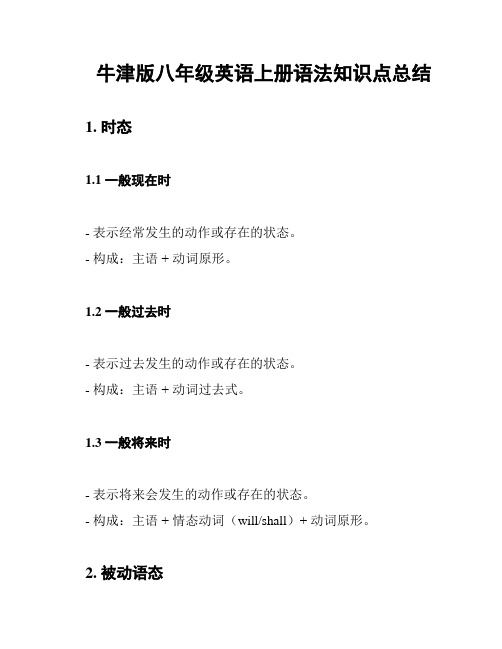
牛津版八年级英语上册语法知识点总结1. 时态1.1 一般现在时- 表示经常发生的动作或存在的状态。
- 构成:主语 + 动词原形。
1.2 一般过去时- 表示过去发生的动作或存在的状态。
- 构成:主语 + 动词过去式。
1.3 一般将来时- 表示将来会发生的动作或存在的状态。
- 构成:主语 + 情态动词(will/shall)+ 动词原形。
2. 被动语态2.1 被动语态的构成- 一般现在时:主语 + am/is/are + 过去分词。
- 一般过去时:主语 + was/were + 过去分词。
- 一般将来时:主语 + will be + 过去分词。
2.2 被动语态的用法- 强调动作的承受者。
- 表示动作的执行者不重要或未知。
3. 情态动词3.1 情态动词的用法- can表示能力或可能性。
- may表示请求或允许。
- must表示肯定推测或强制。
- should表示应该或建议。
- shall表示承诺或警告。
- will表示意愿或将来时。
3.2 情态动词的辨析- can和may表示可能性,但can表示能力时不能用may替换。
- must表示肯定推测时,后句用否定形式;表示强制时,后句用肯定形式。
- shall和will表示意愿,但shall用于第一人称,will用于第三人称。
4. 句子结构4.1 简单句- 包含一个主语和一个谓语。
- 例如:The cat sleeps.4.2 并列句- 包含两个或多个主语和谓语,用并列连词连接。
- 例如:The cat sleeps, and the dog barks.4.3 复合句- 包含一个主句和一个或多个从句。
- 例如:The cat sleeps when the sun sets.4.4 复杂句- 包含一个主句和两个或多个从句。
- 例如:The cat sleeps when the sun sets, and the dog barks at night.5. 疑问句5.1 一般疑问句- 采用倒装结构,将助动词或情态动词移至主语前。
初中英语知识点总结牛津版

初中英语知识点总结牛津版一、词汇与短语1. 基础词汇- 常见名词:家庭成员、学校科目、日常用品、颜色、数字、天气等。
- 动词:一般现在时、一般过去时、现在进行时的常用动词。
- 形容词和副词:描述人、物、地点的特征及其程度。
- 代词:人称代词、物主代词、反身代词、指示代词等。
2. 短语搭配- 动词短语:如“take off”(起飞)、“look after”(照顾)等。
- 介词短语:如“in time”(及时)、“at the moment”(此刻)等。
- 常用表达:问候、告别、请求、邀请、道歉等日常交际用语。
二、语法知识1. 时态- 一般现在时:表示习惯性动作或普遍真理。
- 一般过去时:描述过去发生的动作或状态。
- 现在进行时:表示正在进行的动作。
- 一般将来时:表达将来会发生的动作或计划。
2. 语态- 被动语态:强调动作的承受者,而非执行者。
3. 非谓语动词- 动名词:作为名词使用,可以作主语、宾语等。
- 分词:现在分词和过去分词,用作形容词或副词。
- 不定式:作为名词、形容词、副词等。
4. 句子结构- 简单句:一个主语和谓语构成的句子。
- 并列句:用并列连词连接的两个或多个简单句。
- 复合句:包含主句和从句的复杂句子。
5. 从句- 名词性从句:包括主语从句、宾语从句、表语从句和同位语从句。
- 定语从句:修饰名词或代词的从句,由关系代词或关系副词引导。
- 状语从句:表示时间、地点、原因、条件、结果等,由从属连词引导。
三、阅读理解1. 阅读技巧- 快速阅读:通过扫读抓住文章大意。
- 精读:深入理解文章细节和深层含义。
- 推理判断:根据上下文推断生词或隐含信息。
2. 阅读题型- 事实细节题:寻找文章中的具体信息。
- 主旨大意题:确定文章的主要观点或目的。
- 推理判断题:根据文章内容进行逻辑推理。
- 词义猜测题:猜测生词或短语的含义。
四、写作技巧1. 文章结构- 引言:开篇引入话题,提出观点或问题。
牛津版初中英语语法大全教学内容

牛津初中英语语法1人称代词主格I, you, he, she, it, we, you, they宾格me, you, him, her, it, us, you, them2物主代词形容词性my, your, his, her, its, our, their名词性mine, yours, his, hers, its, ours, theirs3反身代词myself, yourself, himself, herself, itself, ourselves, yourselves, themselves 4指示代词this, that, these, those, such, some5疑问代词who, whom, whose, which, what, whoever, whichever, whatever6关系代词that, which, who, whom, whose, as7不定代词one/ some/ any, each/ every, none/ no, many/ much, few/ little/ a few/ a little, other/ another, all/ both, neither/ eitherII. 不定代词用法注意点:1. one, some与any:1) one可以泛指任何人,也可特指,复数为ones。
some多用于肯定句,any多用于疑问句和否定句。
One should learn to think of others.Have you any bookmarks? No, I don’t have any bookmarks.I have some questions to ask.2) some可用于疑问句中,表示盼望得到肯定的答复,或者表示建议,请求等。
Would you like some bananas? Could you give me some money?3) some 和any修饰可数名词单数时,some表示某个,any表示任何一个。
深圳牛津初中英语语法总汇

深圳牛津初中英语语法总汇■名词(一)概述名词是表示人、地方、事物或抽象概念名称的词,可以说名词是万物之名称。
它们可以是:人的名字Li Ming, Tom 地方名称China, London 职业称呼teacher, doctor物品名称pencil, dictionary 行为名称study, invention 抽象概念history, grammar(二)普通名词和专有名词1.普通名词凡不属于特定的人名、地名、事物名称或概念名称的名词,都属于普通名词。
这类名词在所有的名词中占绝大多数。
普通名词大致有以下四种类型:1)个体名词个体名词指作为个体而存在的人或物。
可以指具体的人或物,例如:He has two aunts. 他有两个姑姑。
Most classrooms have computers. 多数教室里都有电脑。
也可指抽象东西,例如:We’ve lived here for twenty years. 我们在这里住了二十年了。
I had a dream last night 我昨晚做了一个梦。
个体名词有复数形式,如:weeks, problems;单数形式可以和a/an连用,如:a week, a problem, an old man.2)集体名词集体名词表示由个体组成的集体,下面是一些常见的集体名词:family(家,家庭)army(军队)company(公司;全体船员)enemy(敌人)government (政府)group(小组,团体)public(公众)team(队;组)police(警方)集体名词有时作单数看待,有时作复数看待。
一般说来,视为整体时作单数看待,例如:有的集体名词通常用作单数,例如:Our company is sending him to work in Berlin. 我们公司将派他去柏林工作。
有的集体名词多作复数看待。
例如:The police are looking for him. 警察正在找他。
牛津七年级英语语法点大全及海量习题

牛津7AModule 1 Change语法重点:1. 一般将来时2.形容词比较级(参见9B Charpter 6详解)3.情态动词must与have to,can 与be able to 的用法(参见8B Chapter 4详解)4.名词所有格5. 频率副词的用法6.一般疑问句7. 祈使句知识梳理:一、一般将来时(1)概念:一般将来时表示将来某一时刻的动作或状态,或将来某一段时间内经常的动作或状态。
(2)构成:a.一般将来时由助动词shall(第一人称),will(第二、三人称)+动词原形构成。
b. “ be going to+动词原形”表示即将发生的或最近打算进行的事。
c. go,come,start,move,sail,leave,arrive,stay等可用进行时态表示按计划即将发生的动作.e.g. I'm leaving for Beijing.(3) 用法: 表示将来的动作或状态。
一般将来时常与一些表示将来的时间状语连用,如:tomorrow(明天),next week(下周),from now on(从现在开始);in the future(将来)等。
(4)一般将来时will 与be going to两者都可表示将要发生的事、将要去做某事,该怎么区分它们?a. be going to 表示近期、眼下就要发生的事情,will 表示的将来时间则较远一些,如:He is going to write a letter tonight.He will write a book one day.b. be going to 表示根据主观判断将来肯定发生的事情,will表示客观上将来势必发生的事情。
He is seriously ill. He is going to die.He will be twenty years old.c. be going to 含有“计划,准备”的意思,而will 则没有这个意思,如:She is going to lend us her book.He will be here in half an hour.d.在有条件从句的主句中,一般不用be going to, 而多用will, 如:If any beasts comes at you, I'll stay with you and help you.考点考点1:“主将从现”(在时间和条件状语从句中,主句用一般将来时,从句用一般现在时)。
初中英语知识点总结牛津
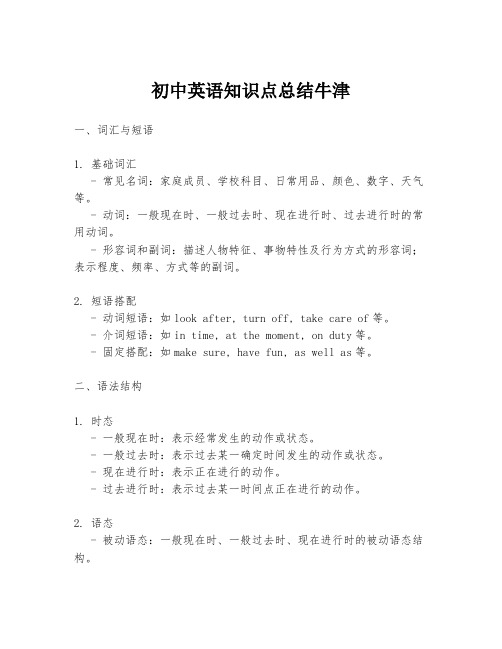
初中英语知识点总结牛津一、词汇与短语1. 基础词汇- 常见名词:家庭成员、学校科目、日常用品、颜色、数字、天气等。
- 动词:一般现在时、一般过去时、现在进行时、过去进行时的常用动词。
- 形容词和副词:描述人物特征、事物特性及行为方式的形容词;表示程度、频率、方式等的副词。
2. 短语搭配- 动词短语:如look after, turn off, take care of等。
- 介词短语:如in time, at the moment, on duty等。
- 固定搭配:如make sure, have fun, as well as等。
二、语法结构1. 时态- 一般现在时:表示经常发生的动作或状态。
- 一般过去时:表示过去某一确定时间发生的动作或状态。
- 现在进行时:表示正在进行的动作。
- 过去进行时:表示过去某一时间点正在进行的动作。
2. 语态- 被动语态:一般现在时、一般过去时、现在进行时的被动语态结构。
3. 非谓语动词- 动名词:作为主语、宾语或表语等。
- 分词:现在分词和过去分词作定语、状语或补语。
4. 情态动词- can/could, may/might, must, should/ought to等的用法。
5. 代词- 人称代词、物主代词、反身代词、指示代词、疑问代词等。
6. 句子结构- 简单句、复合句(并列句和主从句)。
- 宾语从句、定语从句、状语从句。
三、听力与口语1. 听力技巧- 预测:根据上下文和问题预测答案。
- 捕捉关键信息:注意数字、人名、地点等。
- 理解语境:通过语气、语速等判断说话者意图。
2. 口语表达- 日常交流:问候、自我介绍、购物、旅游等。
- 描述和叙述:讲述个人经历、描述人物和事件。
- 观点表达:表达喜欢、不喜欢、同意、不同意等观点。
四、阅读与写作1. 阅读理解- 快速阅读:获取文章大意。
- 精读:理解细节、推理判断、猜测词义。
- 题型技巧:选择题、判断题、填空题等解题策略。
深圳牛津初中英语语法总汇
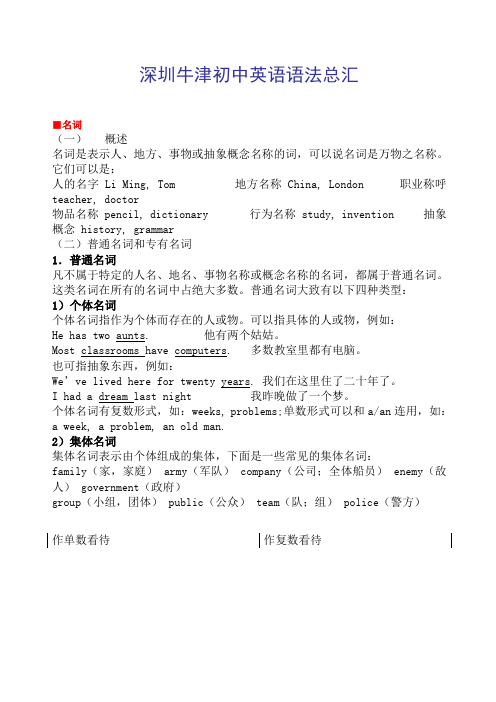
深圳牛津初中英语语法总汇■名词(一)概述名词是表示人、地方、事物或抽象概念名称的词,可以说名词是万物之名称。
它们可以是:人的名字 Li Ming, Tom 地方名称 China, London 职业称呼teacher, doctor物品名称 pencil, dictionary 行为名称 study, invention 抽象概念 history, grammar(二)普通名词和专有名词1.普通名词凡不属于特定的人名、地名、事物名称或概念名称的名词,都属于普通名词。
这类名词在所有的名词中占绝大多数。
普通名词大致有以下四种类型:1)个体名词个体名词指作为个体而存在的人或物。
可以指具体的人或物,例如:He has two aunts. 他有两个姑姑。
Most classrooms have computers. 多数教室里都有电脑。
也可指抽象东西,例如:We’ve lived here for twenty years. 我们在这里住了二十年了。
I had a dream last night 我昨晚做了一个梦。
个体名词有复数形式,如:weeks, problems;单数形式可以和a/an连用,如:a week, a problem, an old man.2)集体名词集体名词表示由个体组成的集体,下面是一些常见的集体名词:family(家,家庭) army(军队) company(公司;全体船员) enemy(敌人) government(政府)group(小组,团体) public(公众) team(队;组) police(警方)待,想到它的成员时作复数看待:例如:有的集体名词通常用作单数,例如:Our company is sending him to work in Berlin. 我们公司将派他去柏林工作。
有的集体名词多作复数看待。
例如:The police are looking for him. 警察正在找他。
- 1、下载文档前请自行甄别文档内容的完整性,平台不提供额外的编辑、内容补充、找答案等附加服务。
- 2、"仅部分预览"的文档,不可在线预览部分如存在完整性等问题,可反馈申请退款(可完整预览的文档不适用该条件!)。
- 3、如文档侵犯您的权益,请联系客服反馈,我们会尽快为您处理(人工客服工作时间:9:00-18:30)。
牛津初中英语语法汇总1. 名词2. 代词3. 数词4. 介词和介词短语5. 连词6. 形容词(比较级、最高级)7. 副词(比较级、最高级)8. 冠词9. 动词(……情态动词) 10. 时态 : 现在进行时一般现在时一般过去时一般将来时过去进行时过去将来时过去完成时现在完成时 11. 被动语态12. 非谓语动词:动词不定式13. 主从复合句宾语从句状语从句(if,unless,although,so that )定语从句(who,that,which) 14. 直接引语与间接引语牛津初中英语语法归纳7A Unit 1一般现在时 (is /am/are, do / does)的肯定、否定和疑问形式。
例:My hair is long.Cats eat fish.He goes to school on foot every day.7A Unit 21.人称代词——主格:I , you , he, she, it, we, they. 在句中作主语。
例: We/ I / You/ They have lunch at school. He / She/ It looks at me. 2.人称代词——宾格:me, you, him, her, it, us, them在句中作宾语。
例: The teacher often helps us / me/ him/ her/ them.7A Unit 3时间介词 at, on, in疑问词:what, which, who, whose, when, where, why, how some, any 的用法7A Unit 4频率副词 never, seldom, sometimes, often, usually, always There be 结构表示“某个地方客观存在”。
7A Unit 5现在进行时 is/ am/are + doing 表示正在进行的动作.7A Unit 6can , may表示“允许、可以”。
顺序副词: first, then, next, afterwards, finally.7B Unit 1方位介词:in front of, between, next to, between, opposite, on 基数词:one, two, three, four,…序数词:first, second, third, fourth….7B Unit 2how much, how many.表示“多少”,前者跟不可数名词,后者跟可数名词的复数。
名词所有格: Millie’s home, The two students’ homes.... 形容词性物主代词:my, your, his , her, our, their, its 名词性物主代词:mine, yours, his, her, ours, theirs, its… 4. 定冠词the的用法: 独一无二的,前文已提到过的。
7B Unit 3动作介词: across, along, through, over, to, up, down, round, from一般将来时:will +动词原形, shall + 动词原形(但只能用于we/ I 第一人称) is/ am/ are going to + 动词原形7B Unit 4一般过去时的肯定、否定和疑问形式。
be 动词的过去式:was/ weredo(实义动词)的过去式分规则和不规则两类。
7B Unit 5用can/ could表示“能力”“会”。
I can speak English. I could swim when I was young. 用can/ could 表示“可能”“可能性”。
I am free. I can help you. At that time, anything could happen. 感叹句 What a good girl! What bad weather! How nice it is! 7B Unit 6祈使句的肯定形式和否定形式:Walk the dog at 7:00. (Please) don’t chase the cat. 情态动词should, ought to & must 的用法should (应该)/ shouldn’t(不应该),ought to(应该)/ ought not to(不应该), must (必须)/ mustn’t (不可以,不允许)8A Unit 11. 描述性形容词,如:short, long, round, interesting,funny, slim, important, beautiful等。
2.形容词的比较级和最高级①规则的bigger / the biggest more important/ the most important②不规则的 worse / the worst表示“比较”的句式:as + 形容词+as ----- “和。
一样” not as / so + 形容词 + as——“。
不如。
”8A Unit 2比较两者间的数量用以下句式:more….than, fewer….than., less… than 例: I have more / fewer apples than you. (后跟复数名词)I have more / less free time than he/ him.(后跟不可数名词) 2.比较两者以上间的数量用 the most, the fewest, the least. 例: Amy scored the most/ fewest points of all. Daniel has the least money of the three.. 3.用 like & alike 来比较。
例:My skirt is / looks like hers. = My skirt and hers are alike. 4. 用词组 the same as & be different from来比较8A Unit 31. and, but, or(或者)的用法。
2. 动词+ to do 这些动词有:plan, agree, want, decide, choose, hope, learn, prepare等。
3.反身代词:myself, yourself, yourselves, ourselves, himself, herself, itself, themselves8A Unit 4由if引导的条件状语从句1. 用来描述可能出现的情况,主句时态用将来时,如: If it doesn’t rain tomorrow, we will go to the park..2.用来描述反复的、可预见的情况,主句时态用一般时。
如:If tigers are hungry, they attack people.8A Unit 51. 用一般现在时表示“将来”。
如:The train leaves at 9:00. 2.用现在进行时表示“将来”,如:We are leaving for Shanghai this evening. 3.方式副词:quietly, gently, easily, well…往往由形容词+ly变成副词,如: quiet – quietly, easy—easily, possible – possibly 少数副词和形容词同形,如:fast, early, long 等。
注意:good—well, near—nearly , hard -- hardly8A Unit 61. 表示原因的连词:because , as, since. (这些词放在原因从句之前,主句不能再用so.)2.表示命令、请求、建议的句式:tell / ask / order /advise / warn sb. (not) to do sth.8B Unit 1 现在完成时结构: have / has + PP 表示动作发生在过去但对现在仍有影响。
肯定、否定和疑问形式常用的一些时间状语,如:already, ever, for, since, just, never, yet等。
for + 一段时间, since + 过去的一点时间/ 用过去式的从句,相对应的主句动词要用延续性动词,如:leave --- be away, die --- be dead, borrow ---- keep, buy—have, come ---be here, join –- be in/ be a member of 等。
如: He has left already.He has been away for two hours.8B Unit 21. 过去进行时 was / were + doing 表示过去某个时刻正在进行的。
2. 肯定、否定和疑问形式.3. while 和 when在过去进行时中的用法:进行时+ while +进行时过去式,while + 进行时 = when +过去式,进行时例:I was doing my homework while my father was watching TV..The bell rang while he was reading books.When the bell rang, he was reading books. (以上这两句主从句前后可以互换)8B Unit 3 被动语态结构:be + PP 时态变化都只改变be 的各种形式肯定、否定和疑问形式不是所有的动词都有被动形式,如感觉动词: feel, smell, look, taste, sound 和 happen, take place 等。
主动形式表被动意义,如: This shirt sells well. (详细见课件复习)8B Unit 4because, because of, so 的用法。
because + 从句, because of +短语 (but: what you said), 两者后都跟原因。
so 后跟结果的从句。
同一句子中,不能同时出现because/ because of和 so. 2.hope & wish的用法hope 所希望的是有可能实现的,但wish所希望的是现在不可能实现的。
如:I hope you can come to my party.I wish I were the President.3.主语 hope to do sth., 主语hope其他人做某事,要跟从句。
